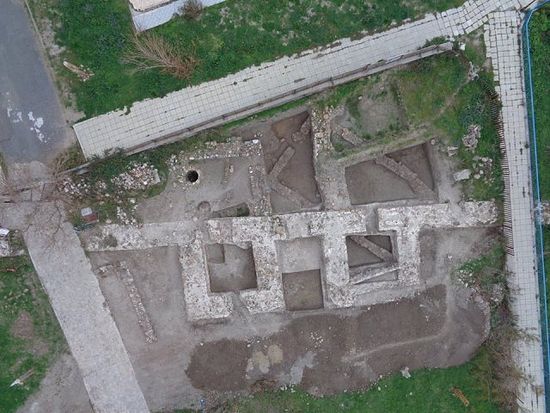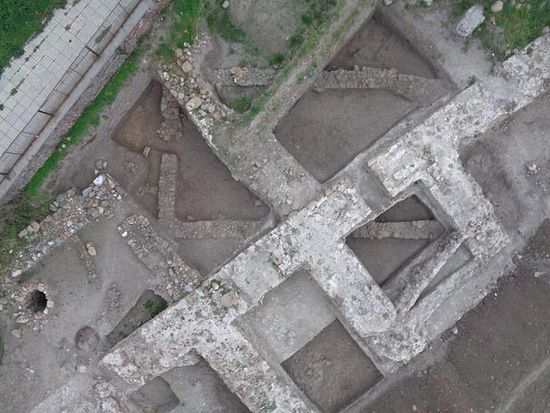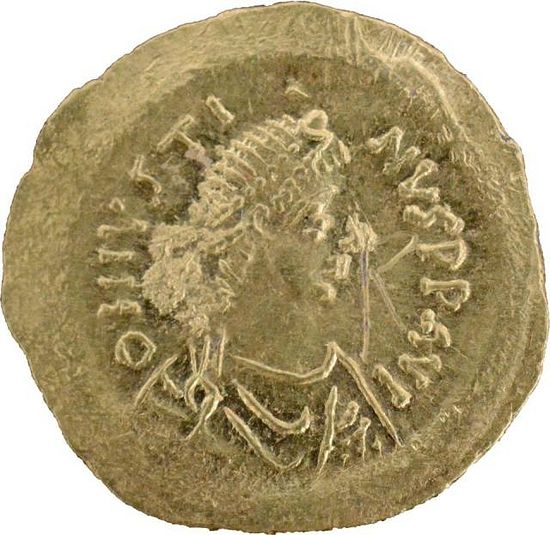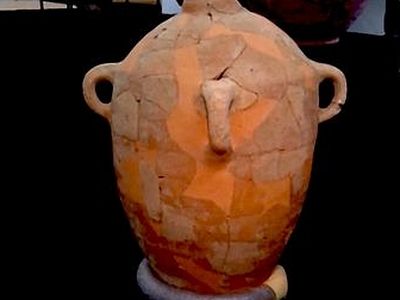Source: Archaeology in Bulgaria
January 15, 2016
 An aerial photo of the newly discovered northern gate of the Late Antiquity fortress of Agathopolis in Bulgaria’s Ahtopol on the Black Sea with its two towers. Photo: Tsarevo Municipality Facebook Page
An aerial photo of the newly discovered northern gate of the Late Antiquity fortress of Agathopolis in Bulgaria’s Ahtopol on the Black Sea with its two towers. Photo: Tsarevo Municipality Facebook Page
Bulgarian archaeologists have unearthed the northern gate of the Late Antiquity and medieval fortress of Agathopolis, today’s Bulgarian Black Sea town of Ahtopol, a major Byzantine and Bulgarian fortress during the Middle Ages, which was also an Ancient Greek, Thracian, and Roman city in the Antiquity period.
For two months at the end of 2015, archaeologists from Bulgaria’s National Institute and Museum of Archaeology in Sofia led by Assist. Prof. Dr. Andrey Aladzhov excavated the ruins of ancient Agathopolis, the press service of Tsarevo Municipality has announced.
The archaeologists’ efforts were supported byvolunteers from Bulgaria, Canada, and theNetherlands. The digs were founded by bothBulgaria’s Ministry of Culture and Tsarevo Municipality.
Ancient Agathopolis known as Peronticus in the Roman period was settled by Ancient Greek colonists from Athens in 430 BC.
The small Ahtopol Peninsula, however, which is 300 meters long and 150 meters wide, has had traces of civilized life going back as early as theNeolithic. During the Iron Age, it was inhabited by the Ancient Thracian tribe Thyni. It was colonized by the Romans in the 2nd century AD.
The fortress of Agathopolis was built by the Eastern Roman (Byzantine) Empire in the 6th century AD.
In addition to discovering the façade of thenorthern gate of the Late Antiquity fortress of Agathopolis, the archaeologists have also unearthed the interior of the gate’s two fortress towers, a Late Roman building, a necropolisfrom the Late Middle Ages and buildings that were burned down in the early 20th century.
 The ruins of a Late Roman stone building destroyed in the barbarian invasions in the 4th century AD are seen underneath the fortress wall and gate built in the 6th century. Photo: Tsarevo Municipality Facebook Page
The ruins of a Late Roman stone building destroyed in the barbarian invasions in the 4th century AD are seen underneath the fortress wall and gate built in the 6th century. Photo: Tsarevo Municipality Facebook Page
However, the most interesting newly discovered archaeological structure in Bulgaria’s Ahtopol is said to be the Late Roman stone building which was constructed before the Early Byzantine fortress.
“This Late Roman settlement which was burned down shows what the fate of the Roman [city of] Ahtopol was at the time of the Great Exodus when Huns, Goths, Vandals, and other peoples started to devastate the Eastern Roman Empire after the middle of the 4th century," the archaeologists explain.
“It was no accident that after these events Ahtopol was fortified with a mighty fortress wall," they add.
During the excavations of the western fortress tower of the northern gate of Agathopolis, thearchaeologists have found that it was rebuilt in the Late Middle Ages.
The nature of the reconstruction shows that it was hastily done, and the researchers believe it occurred during the devastating raids on Ahtopol by the navy of the Italian city-state Genoa in 1352.
This conclusion is also said to be confirmed by the discovery of numerous cannon balls like the ones used by the Genoese fleet.
According to the statement of Tsarevo Municipality, the most important result from the 2015 excavations of the Late Antiquity and medieval fortress in Ahtopol is the stratigraphic analysis that dates precisely its construction periods.
In addition to the Genoese cannon balls, the ancient and medieval artifacts found by the archaeologists include clay lamps, glass vessels, perfume vessels, luxury dishes, and lots of coins.
 This newly found gold coin of Byzantine Emperor Justine I (r. 518-527 AD) was minted to pay for the construction of the Early Byzantine Fortress in Agathopolis but was never in use, according to the archaeologists. Photo: Tsarevo Municipality Facebook Page
This newly found gold coin of Byzantine Emperor Justine I (r. 518-527 AD) was minted to pay for the construction of the Early Byzantine Fortress in Agathopolis but was never in use, according to the archaeologists. Photo: Tsarevo Municipality Facebook Page
The most exciting find of those is a gold coin of Byzantine Emperor Justin I (r. 518-527 AD).
The archaeologists say the coin is “brand-new", i.e. it has never been in use because it still has its“production polish".
It is seen as “an excellent piece of evidence about the construction of the fortress in the early 6th century", which appears to have been its first construction period.
Earlier some scholars had hypothesized that the Agathopolis fortress was built during the reign of Emperor Anastasius I Dicorus (r. 491-518 AD).
Numerous coins from the reigns of Emperor Justinian I the Great (r. 527-565 AD) and Maurice (r. 582-602 AD) have also been found. They are attributed to the second construction period of the fortress in Ahtopol, the third quarter of the 6th century.
The last reconstructions of Ahtopol’s medieval fortifications have been found to have been made during the period from the middle of the 14th century until the beginning of the 15th century, the archaeologists conclude.
Background Infonotes:
The ruins of the ancient city of Agathopolis, today’s Bulgarian Black Sea resort town of Ahtopolin Tsarevo Municipality, Burgas District, are located on the Ahtopol Peninsula which is about 300 meters long and 150 meters wide, at the foot of the Strandzha Mountain.
The site’s civilized life goes back to the Neolithic. During the Iron Age, the area was populated by the Ancient Thracian tribe Thyni. The discovery of a votive tablet with an inscription and the image ofHeros, also known as the Thracian Horseman, the supreme god in the Thracian mythology, attests to their presence.
The city itself was most probably founded in 430 BC by Ancient Greek colonists from Athens,potential as part of Pericles’ actions in the Black Sea during the Peloponnesian War. The Ancient Greek polis had its own mint and coins.
While it was part of the Roman Empire (1st-4th century AD), the city was called Peronticus. Later, as part of Eastern Roman (Byzantine) Empire, it suffered destruction in the barbarian invasions of Avars and Slavs in the 5th-7th century AD, it was rebuilt by Byzantine general Agathon. Some hypotheses say that he named the city after himself but others say that it was called Agathopolis much earlier, at least since 323 BC.
According to one legend, Agathopolis was first established as the home of Delphin, son of Poseidon, and Agatha, daughter of Zeus. Zeus was angered by their relationship so he dispatched an army against them but a burrowing owl woke them up and saved them. Thus, Delphin killed the enemies and founded a city called Agapi-polis (city of love) on the Black Sea coast.
In 131 AD, Ahtopol was mentioned as Auleuteichos in the Perlus of the Euxine Sea, a guidebook of the Black Sea towns, by Greco-Roman historian Arrian of Nicomedia, as being located 43.5 km away from Chersonesus (another Ancient Greek city on the Bulgarian Black Sea coast with the same name as theAncient Greek colony on the Crimean (Taurica) Peninsula).
In the 6th century AD, a fortress wall was built to defend the city against the barbarian invasions, possibly during the reign of Byzantine Emperor Anastasius I Dicorus (r. 491-518 AD) or Emperor Justin I (r. 518-527 AD). Parts of this Late Antiquity Fortress wall are still preserved up to a height of 3-4 meters; the walls are thick between 1.5 and 2.8 meters.
Agathopolis was first conquered by the First Bulgarian Empire (632/680-1018 AD) under Khan Krum (r. 802-813 AD) in 812 AD. It was settled with Slavs under his successor, Khan Omurtag (r. 814-831 AD). Subsequently, during the Middle Ages, the city changed hands between the Bulgaria and the Byzantine Empire numerous times.
It was part of Bulgaria until 864 AD, and then again from 894 until 970 AD. Arab geographer Muhammad Al-Idrisi mentioned Agathopolis as a major city in 1150 AD. At the time of the Second Bulgarian Empire (1185-1396 AD), the region of Agathopolis was reconquered by the Bulgarians in the Uprising of Asen and Petar in 1185. It was part of Bulgaria until 1263, and was then reconquered in 1304, in the Battle of Skafida near Poros (Burgos, today’s Burgas).
The city changed hands between Bulgaria and Byzantium several more times until the end of the 14th century. Before that, in 1366 AD, the Count of Savoy Amadeus IV (r. 1343-1383) conquered Ahtopoland the other cities on Bulgaria’s southern Black Sea coast for five months. It was ultimately conquered by the Ottoman Turks in 1453, together with the conquest of Constantinople and the othersurviving Byzantine ports in the Mediterranean and the Black Sea.
During the period of Ottoman Yoke, i.e. when Bulgaria was part of the Ottoman Empire, Ahtopol remained an important port. Ahtopol was visited in 1663 by Ottoman traveler Evliya Celebi, and was mentioned in his books of travels as “Ahtabolu". It was liberated by Bulgaria in the Balkan War of 1912.



